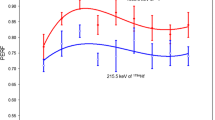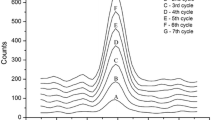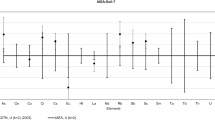Abstract
The k 0-based cyclic neutron activation analysis (k 0-CNAA) technique has been studied to explore the applicability at the Portuguese research reactor (RPI). In particular, for the determination of elements which form short-lived radionuclides, particularly fluorine (20F, 11.16 s half-life) and selenium (77mSe, 17.36 s half-life) in polymer, biological and environmental samples. The detection limits obtained for F and Se were about 50 and 0.01 mg kg−1, respectively, in the investigated materials. The timing parameters for the procedure were 10 to 20 s for irradiation, 5 s decay, 10 to 20 s counting, 5 s waiting and performed with eight cycles. The k 0-IAEA program was modified to use millisecond time resolution for irradiation, decay and counting times as needed for interpreting k 0-CNAA data in terms of concentration, accuracy and detection limit. The quality control of the procedure was performed by preparing a standard solution containing fluorine with different contents as well as using the certified reference materials containing selenium from which the bias between the results and the certified values were within 15% for most elements at the investigated content ranges. The analytical results for several other elements producing short-lived or detectable radionuclides, e.g., Al, Ca, Cl, Cu, Dy, I, Mg, Mn, Ti, and V were also obtained by the k 0-CNAA procedure with accuracy within 12%.


Similar content being viewed by others
References
Spyrou NM (1981) J Radioanal Chem 61:211–242
Chatt A, Desilva KN, Holzbecher J, Stuart DC, Tout RE, Ryan DE (1981) Can J Chem 59:1660–1664
Hou X (2000) Encyclopaedia of analytical chemistry. In: Meyers RA (ed) Cyclic activation analysis. Wiley, Chichester, pp 12447–12459
DeCorte F (1987) The k 0 standardization method—a move to the optimization of NAA, Habilitation Thesis. University of Gent, Gent
Blaauw M (1993) J Appl Radiat Isot 44:1225–1229
Dung HM, Freitas MC, Sarmento S, Blaauw M, Beasley D (2008) J Radioanal Nucl Chem 278:621–625
Dung HM, Freitas MC, Santos JP, Marques JG (2010) J Nucl Instrum Methods A622:438–442
Diaz Rizo O, Manso Guevara MV, Herrera Peraza E, Alvarez Pellon I, Lopez Reyes MC (1997) J Radioanal Nucl Chem 221:241–244
Blaauw M (2009) The k 0-IAEA program manual. IAEA, Vienna
Spyrou NM, Adesanmi C, Kidd M, Stephens-Newsham LG, Ortaoval AZ, Ozek F (1982) J Radioanal Chem 72:155–182
Blaauw M (1993) J Nucl Instrum Methods A336:273–277
Dung HM, Freitas MC, Blaauw M, Almeida SM, Dionisio I, Canha NH (2010) J Nucl Instrum Methods A 622:392–398
Hou X, Das HA (1997) J Radiaanal Nucl Chem 223:67–72
Roelandts I, Gladney ES (1998) Fresenius J Anal Chem 360:327–338
Alfassi ZB, Lavi N (1982) J Radiochem Radioanal Lett 53:173–182
DeCorte F, Simonits A (2003) J Atom Data Nucl Data Tables 85:47–67
Brookes CJ, Betteley IG, Loxton SM (1979) Fundamentals of mathematics and statistics for students of chemistry and allied subjects. Wiley, New York
Acknowledgments
The authors would like to thank the financial support of Portuguese Foundation for Science and Technology (FCT), through the projects coded: REEQ/1075/FIS/2005, PTDC/SAU-ESA/65597/2006 and PTDC/QUI/65618/2006. Thanks are due to H. M. Anawar and C. Galinha for sample’s preparation and J. G. Marques, A. R. Ramos Wahl and operators of RPI reactor for their help in many ways.
Author information
Authors and Affiliations
Corresponding author
Rights and permissions
About this article
Cite this article
Dung, H.M., Blaauw, M., Beasley, D. et al. Development of the k 0-based cyclic neutron activation analysis for short-lived radionuclides. J Radioanal Nucl Chem 291, 485–492 (2012). https://doi.org/10.1007/s10967-011-1317-2
Received:
Published:
Issue Date:
DOI: https://doi.org/10.1007/s10967-011-1317-2




